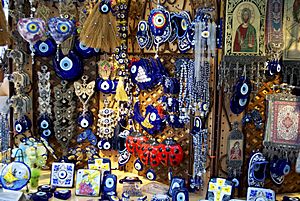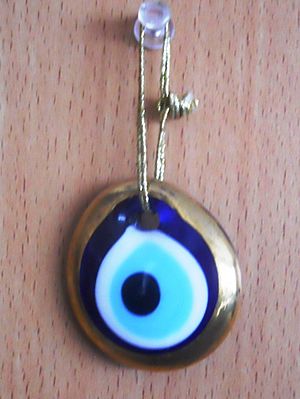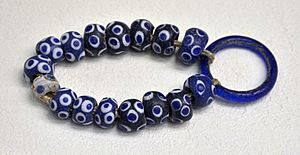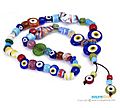Nazar (amulet) facts for kids

A nazar is a special eye-shaped amulet or charm. People believe it helps protect them from something called the evil eye. The word "nazar" comes from Arabic and means "sight" or "attention."
This charm is known by different names in many countries. In Turkey, it's called a nazar boncuğu, which means "nazar bead." In Greece, it's known as mati. People in Persia and Afghanistan call it a cheshm nazar.
Many cultures believe that someone can accidentally give you the evil eye. This might happen if they are very envious of something you have. For example, if someone praises your new phone too much, they might unknowingly give you the evil eye. This belief suggests that the evil eye can make you feel unwell the next day. To prevent this, people might say phrases like "with the will of God" (mashallah in Arabic).
The idea of the nazar started a very long time ago in Mesopotamia. From there, it spread to countries around the Mediterranean Sea through trade. In 2018, the nazar was even added to Unicode as a special symbol: Error using : Input "1F9FF" is not a hexadecimal value..
What is a Nazar Amulet?
A typical nazar amulet is usually made from handmade glass. It has different colored circles or teardrop shapes. These colors are often dark blue, white, light blue, and black. Sometimes, it has a yellow or gold edge.
The bead is made from a mix of melted glass, iron, copper, water, and salt. People believe these ingredients help protect against evil. In Turkey, many think the color blue acts like a shield. It is thought to absorb negative energy.
In ancient times, blue eyes were quite rare in the Middle East and Mediterranean. Because of this, some people believed that those with light-colored eyes could put a curse on others with just a look. This belief was so old that even the Assyrians used turquoise and blue-eye amulets.
The Eye Bead's History
The Turkish boncuk, also called a göz boncuğu or eye bead, is a glass bead. It has a blue glass background with a blue or black dot. This dot is placed on a white or yellow center. This blue bead is very old and has become an important part of Turkish culture today.
These beads likely first appeared in the Mediterranean region. Their creation is linked to the development of glass making. We have written records and actual beads from as far back as the 16th century BC. Glass beads were made and used widely across the ancient world. They were found from Mesopotamia to Egypt, and from Carthage to Rome.
There's a popular story about these beads. It says that if a nazar bead breaks, it means a very strong evil eye has tried to harm you. The bead is believed to have absorbed all that bad energy and broke to keep you safe.
Gallery
-
A nazar on a newborn baby's hospital room door in Turkey.
See also
 In Spanish: Nazar (amuleto) para niños
In Spanish: Nazar (amuleto) para niños
- Eye of Providence
- God's eye
- Evil eye
- Darśana
- Eyespot (mimicry)
- Görece, Menderes
- Hamsa
- Namkha
- Nazar battu
- Mezuzah
- Skandola
- Ta'wiz










